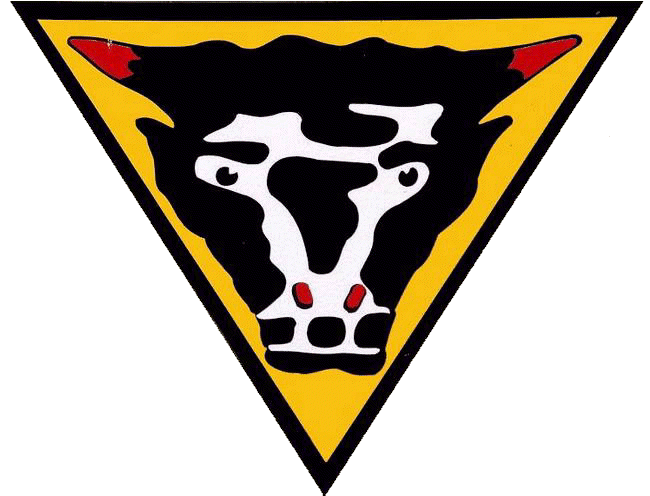
Joe Ingham’s account of preparation for D-Day and his experiences as a Churchill AVRE crewman in 79th Division as Montgomery’s 21st Army Group advanced into Europe in 1944/45.
Three years after the evacuation from Dunkirk, the British decided to form special assault units protected by armour to overcome the considerable obstacles facing any possible invasion of Fortress Europe. In April 1943, a standard armoured division which was about to be disbanded, was reorganised to become the 79th Armoured Division, combining Royal Engineer and Royal Armoured Corps personnel and equipment to lead the D-Day assault on Normandy.
Led by the colourful character, Major General Percy Hobart, a range of heavily modified tanks was quickly developed and used to great effect on the invasion beaches and beyond. The first village in occupied Europe to be liberated on 6 June was captured by a troop of AVREs (Armoured Vehicle Royal Engineers) of 77 Assault Squadron. 79 Armoured Division supported the subsequent advance of 21st Army Group into Normandy and north east across Europe, with important roles in the capture of the flooded estuaries and lowlands around Holland, and the crossing of the Rhine.
After its re-birth as the 79th, Hobart had to find the right sort of men to fill the vacancies. The recently disbanded Gas Warfare units, which included RE personnel with a variety of engineering skills in addition to their gas warfare training, were a useful source as they came with a complete command structure rather than as individuals. As their sub-units were assimilated into the 79th, they simply changed their titles to reflect their new roles: so the 79th Chemical Warfare Company, for example, became the 79th Field Company on attachment to the division, and was later renamed the 79th Assault Squadron after it re-equipped with AVREs for D-Day.
One of the men who was transferred with the 79th Gas Warfare Company was Joe Ingham, a peacetime teacher from the Medway towns.
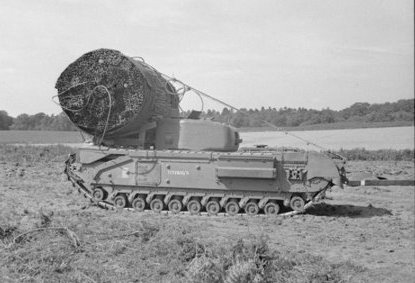
After training on early marks of Churchill gun- tanks in 1943, Joe’s company became the 79th Assault Squadron as mentioned above. They were eventually issued with Mk III AVREs, a version of the Churchill that carried an 11.5in (290mm) spigot mortar used for bunker-busting. In addition, a fascine was carried on the front of the hull, a bundle of tightly-bound brushwood that was used to fill tank-ditches. The AVREs were typically crammed with other RE explosive devices to assist with route-clearance and demolition work.
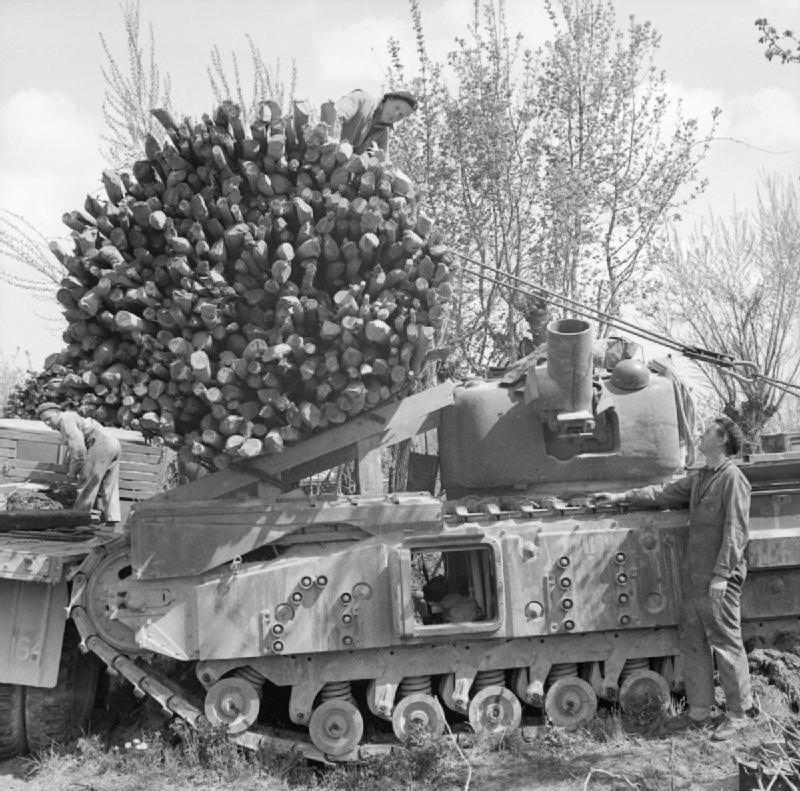
A Churchill Mk III AVRE is loaded with a fascine. The turret had to be pointed off to the side to allow the fascine and ramps to be fitted. Note that the two side hatches in the hull are open and one can see right through the tank.
As might be imagined, when hit by German rounds, an AVRE made an impressive explosion. However, the mortar had a very sort range of only 80 – 100m, so in order to hit its target (even if it were a large bunker) it had to get much closer than an ordinary tank would be capable of doing. To that end, it was fitted with extra armour over the frontal arc, and some stories tell of German 88 shells being unable to stop Churchill AVREs as they lumbered up a gun-emplacement and literally fired a mortar round at point-blank range through the gun-embrasures.
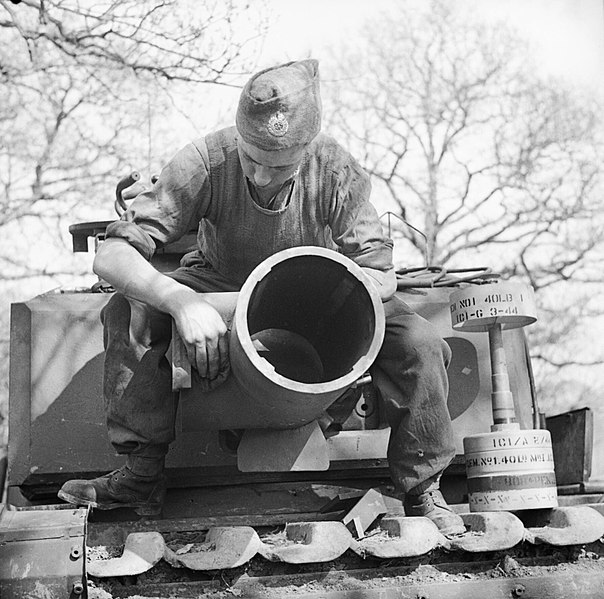
The 29cm Petard spigot mortar on a Churchill AVRE of 79th Squadron, 5th Assault Regiment, Royal Engineers, under command of 3rd Infantry Division, 29 April 1944. A 40lb bomb can be seen on the right. (This might even be Joe Ingham’s AVRE.)
The following are a series of excerpts from an account of the wartime experiences of Joe Ingham compiled in 1994, starting at the point at which 79th Assault Squadron had been issued with new AVREs and were getting ready for some sort of assault on the French coastline in that year – though no-one knew where or when it might take place. Ed.
Joe was posted to Second Troop, 79th Assault Engineer Squadron, 5th Assault Regiment RE, 79th Armoured Division. However, almost all elements of 79th Div were then attached to support other formations and units during operational phases. For example, AVREs might be the first tanks off a landing ship that carried infantry or tanks in order to clear a route through the beach obstacles. For this reason, 79th Armd Div troops were often very much at the sharp end and in the thick of the action.
L/Cpl Joe Ingham’s account of his wartime experiences in 79th Armoured Division written in 1994
”So we now had the weapons to use and now we had to learn how to use them. It was very heavy work as all the devices had to be built and erected on the AVRE’s and they weighed many tons. Even my FASCINE weighed four tons and when an AVRE carried a Small Box Girder (SBG) bridge on the tank’s nose only half of the eleven pairs of boogies were used to run on.
Since all the hand-placed devices and explosives had to be carried inside the AVRE many of the internal fittings had to be removed. Internally the lower half of the turret was cut away so that the tank crew who were normally inside the turret - i.e. the commander, wireless-operator and gunner, had no turret-floor to stand on. They stood on the AVRE floor and had to walk round together when the turret turned. The internal walls of the AVRE were stacked with DUSTBINS, BEEHIVES and WADES. (Different types of demolition charges used to destroy emplacements and similar structures.)
Boxes of detonators and explosives were stacked against the walls and I had to find myself a corner where I could get out of the way until it became my job as Demolition Engineer to get out of the AVRE and do my stuff. Quite literally the AVRE was a mobile explosive steel box. Over a ton of explosive was carried by each AVRE and a direct hit from an enemy shell was lethal. We had one AVRE hit by a shell from a German 88mm gun, it simply exploded and the turret was found over 100 yards away”.
Preparation for D-Day
Ultimately we got to April 1944, and we moved south to an area behind the south coast. I say “we moved” – I should have said, half the world seemed to be moving. The country was alive with sign-posts bearing letters and numbers, with Army police and civilian police, guiding hundreds and hundreds of lorries, motor-cycles, tanks and AVRE’s nearer and nearer to the coast. At last we found ourselves on a vast area of shingle, just like Dungeness, but actually somewhere near Portsmouth. We passed through a high fence made of sacking on steel poles which extended miles all round this vast convoy of vehicles. Then the penny dropped. This was our waiting area. Our next move would be across the Channel.
Our first job was to replace all of our explosives with fresh ones. Snakes had to be emptied and re-filled, AVRE’s had to be re-stocked, all our small-arms ammunition had to be handed in and we were issued with new. There was going to be no slip-up if the organisers could help it! The tracks were cleaned and greased. Mechanics went over the engine, testing all the bits and pieces. And we waited, and waited.
Payday came. And we wondered what had hit us. No nice pound notes or familiar coins. We were given notes about 10cm by 6cm on bearing crossed flags, French and British, and the legend “British Liberation Army”. They were 1 franc, 5 franc, 10 franc and so on, and all told the French that they were the only currency of any value after the invasion.
We packed the AVRE very carefully. The inside walls of the vehicle were stacked with beehives and general wades, there were boxes and boxes of all the paraphernalia of war. The forward compartment housed several mortar-bombs, the “flying-dustbins” which were fired from our mortar. I made sure that my exit-door, in the sidewall behind the machine-gunner, was clear. I wanted to be able to get out, and in again, at speed! By the time all was ready, there wasn’t much room. A fully loaded AVRE weighed forty tonnes.
It was my responsibility to see that our fascine was safely installed, and a suitable charge was put into the release mechanism to blow it apart safely. I did a few sums, and gave it 100gms. I connected the electric cables and led them down through the turret-hatch so that I could blow it up when it was needed. I also had to make sure the water-proofing would work.
First you must imagine cordtex. This looked exactly like heavy-duty electric wiring, and came in large rolls on a wooden drum. It wasn’t electric wiring, of course; it has a core of explosive where the wire would have been. This I wound round the turret-base where it joined the hull, and I let the end hang inside. The turret, of course, was turned so that the mortar faced right, because of the fascine. Next I placed a continuous strip of sealing over the cordtex, and stuck it into position with Bostik. The end of the cordtex was sealed into the Bostik.
The air intakes were made waterproof by adding rectangular “chimneys”, extending level with the top of the turret. These I also made easily disposable with cordtex. The exhaust grills were extended with lengths of pipe held vertical with steel wire stays. The AVRE was ready. So were we, but still we waited.
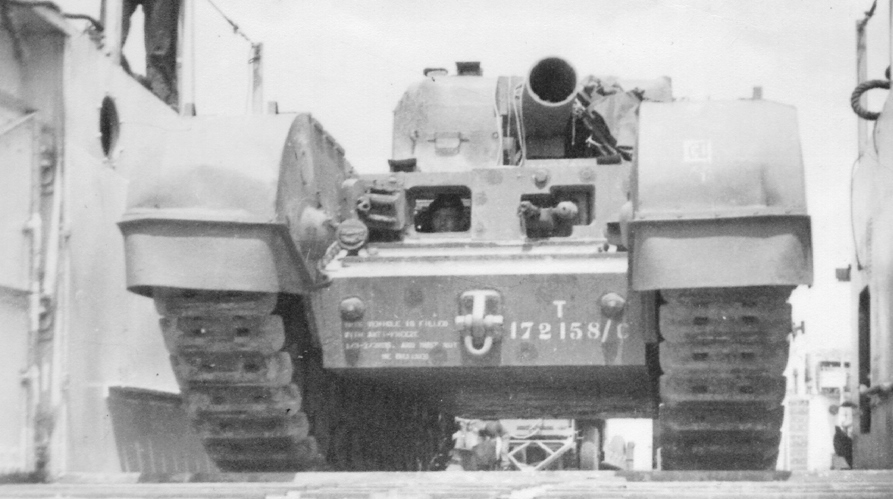
And then at last we moved. Down towards the sea, towards the docks where our ships, Land Craft-Tank, or LCT’s, were waiting. By the time we got to our ship, it looked full. Of course, it wasn’t; there was room for one more AVRE –mine! As my driver reversed up the ramp on to the deck, it suddenly occurred to me – the rule of the ferry: “Last on, first off”. The drop-down door I had just passed on our way up to the dock was raised, and we were on board. I wasn’t to feel English soil under my feet again for a long time.

Hooks had been welded to the flat deck, so that we could chain our AVRE’s down – after all, it might be a bit rough going over. And it made sense that our AVRE had to be the first ashore, because our first job was to clear the beach of hedgehogs so that the second wave of the assault could land safely. We had been told that the tide would be at its lowest so that all the obstacles would be exposed when we landed.
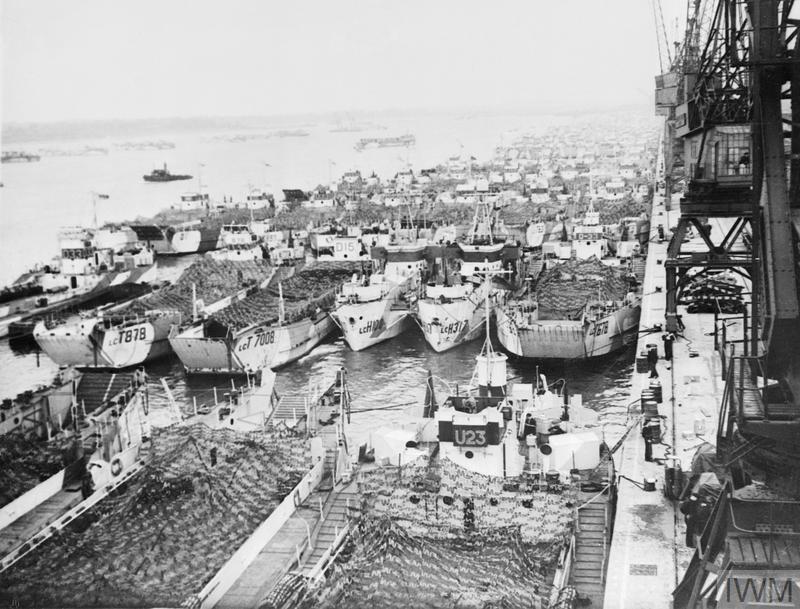
We settled down on the ship. Obviously there weren’t berths for the sudden influx of men which we represented, so we would have to fend for ourselves. I decided to be comfortable. I stretched a canvas sheet between the tracks at the front of the AVRE and made a sort of hammock to sleep in.
We remained on board, in Portsmouth harbour, all next day. Then we were told that the date of D-Day had been decided; we would sail next day, June 4th, and rendezvous in the Channel, to land on the 5th. Our Squadron Leader also told us that we would be given all details once we had left harbour. Meanwhile, we were ordered to re-check everything! Once again I had to go over the vehicle with the metaphorical tooth-comb, checking that all stores and equipment (were) correctly stowed and complete. Then once again we settled down to wait.
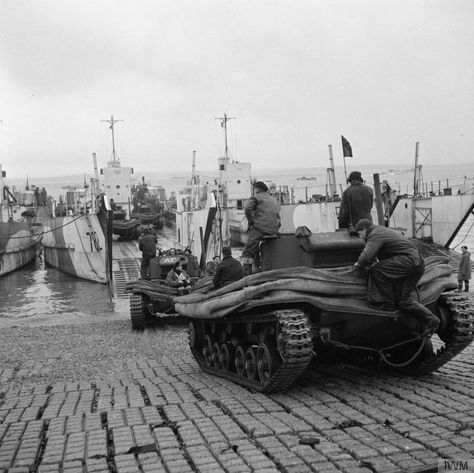
There was one incident which I remember. The captain of our ship, a Lieutenant, asked our Squadron Leader whether one of us could do a painting job for him. I volunteered out of boredom, and he told me he wanted our Squadron Number painted on the ship’s bridge facing forward. So there I was, up a long ladder standing on the deck, and chalked our number, 1233, then painted it in black. I can still remember the sky apparently swinging from side to side above my head as the ship rocked lazily in the swell. Our ship stood out of the crowd, because I painted the threes with flat tops – the Royal Navy usually makes them round!
It was later in the afternoon when we were called together by the CO and told that because of adverse weather forecasts, the departure had been postponed. There was nothing we could do, just grumble and wait. I had been in the Army for nearly four years, and I, and everybody else, wanted to get out there and get the job finished. We had concealed the outlines of the AVRE’s with camouflage netting, we were ready and they were ready. We were getting fed up.
End of Part one.
Part Two will deal with the landing and securing of the D-Day beaches.
The account was submitted by Roger Brown on behalf of Joe Ingham’s family, to whom we are are very grateful for permission to publish Joe’s story.

Comments on An AVRE at D-Day: life in a 79th Armd Div assault sqn